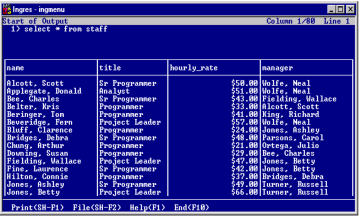Query Language Statement Execution
After specifying query language statements in the workspace, execute them to receive output.
For example, suppose you entered the following ISQL statement in your workspace:
select * from staff
When you choose the Go or Complete operation, the following message displays while retrieving the data:
Run the request
The resulting data displays in the output window for the Interactive Terminal Monitor frame, as shown in the following figure. In this example, all rows from the Staff table in the current database have been retrieved, but not all of the data can fit in the window at the same time.

A Start of Output banner appears at the top of the output window if the data extends beyond the first window:
Start of Output Column 1/80 Line 1
The Column and Line indicators in the Start of Output banner indicate the portion of your output that is currently visible in the window, as determined by a theoretical column and row grid. Each grid column is one character wide. The first number in the Column indicator shows which output column currently appears at the left margin of your window. The number after the slash indicates the total width of the output. In this case, Column 1/80 indicates that the first column of the output appears at the left margin and the total output is 80 columns wide. The Line indicator shows the current line, at the top of the output area.
The database language statements you entered in the input window appear on the output window after the banner. Each statement line is preceded on the same line by a number and a greater than ( >) character. In the preceding figure, the ISQL statement is preceded by 1>.
The rest of the output window contains the data and messages returned by the request. You can scroll the rows of output up and down or left and right in the output window, using your mouse or the keys mapped to the scrolling functions. To go directly to the end of the output, use the key mapped to the Bottom FRS key operation; to go to the top of the output, use the key mapped to the Top FRS key operation.
This figure shows the frame contents at the end of the output.

If the query runs to completion, the Line indicator in the End of Output banner at the top of the output shows the current line at the top of the output area (in this case, Line 24), as well as the total number of lines in the output, including trim, blank lines, and explanatory text (in this case, 42 lines).
An End of Request banner also appears if you:
• Execute the Go operation and all output from the request displays in one window.
• Execute the Complete operation, which runs the request to completion and displays the last portion of the output.
• Scroll the cursor to the last window of data in the output.
The File operation in the output window differs from the File operation in the input window. In the output window, the File operation sends the query output results to a file; in the input window it sends the query language statements to a file.
When you return to the input window, your original query reappears, as shown in this figure.

To edit the current request or execute it again, use the Go or Complete operations. To return to the point at which you last inspected the current output, use the Resume operation. Or, clear the workspace with the Blank operation and enter a new request.
Last modified date: 07/21/2025